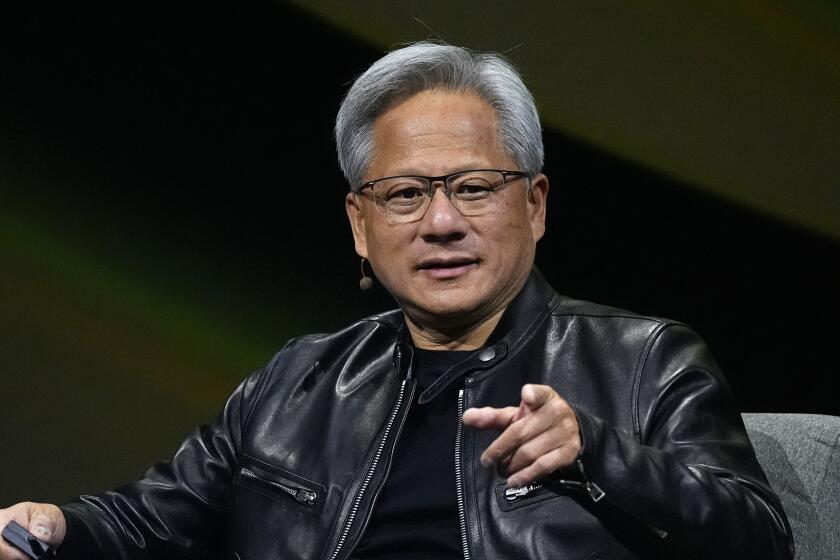Businesses Scrambling as Strike Cripples UPS
Fortune 500 companies, small businesses and inconvenienced consumers found themselves with the same predicament Monday as they scurried to find other ways to ship millions of packages on the first day of a nationwide strike by United Parcel Service of America workers.
“We’ll use whatever is necessary to get our products there the next day,” said Sharon Baer, chief executive of Daisy Wheel Ribbon Co., an Ontario-based provider of computer supplies. “If we have to take them on our hands and knees, we will.”
Conditions were more a nuisance than chaotic; many companies promptly switched to alternate shippers they had lined up in advance. But shippers and customers alike sounded warnings that U.S. parcel delivery could seriously bog down if the strike isn’t settled soon.
UPS--which is owned by its managers and some employees--put more than 20,000 of its managers to work sorting and delivering parcels after members of the International Brotherhood of Teamsters, which represents 185,000 of UPS’ 302,000 U.S. employees, struck the Atlanta-based concern after contract talks failed.
But the company--which is by far the largest player in the parcel-shipping industry--still expects to deliver only 10% to 15% of the 12 million packages it typically moves each day, UPS chief negotiator Dave Murray told a news conference in Washington.
As a result, other delivery firms, such as Federal Express Corp., Airborne Freight Corp. and the U.S. Postal Service, were swamped with additional orders. UPS typically handles an estimated 70% of the nation’s daily parcel-shipping traffic.
Federal Express likened the onslaught to its pre-Christmas rush, even though businesses had been warned that UPS competitors can shoulder only a small part of UPS’ volume.
Indeed, economic damage from the walkout’s first day was minimized because the shipping industry and customers were afforded several days to make emergency plans. The strike was first set for last Friday, then was delayed while UPS and Teamsters negotiators continued talking through the weekend.
“We were anticipating that this would happen,” said Bobbie Bryson, spokeswoman for catalog retailer Lillian Vernon Corp., which is currently shipping 18,000 packages a week. The New Rochelle, N.Y.-based company has shifted its UPS business to the Postal Service “and so far it’s working fine.”
But companies were nearly unanimous in predicting that bottlenecks and business costs could mount rapidly if the strike lasts more than a few days.
“We know that, capacity-wise, the other major shipping companies are not able to handle everyone,” said Lorraine Russell, spokeswoman for Standard Register Co., a Dayton, Ohio-based provider of business stationery. “It’s going to depend on how long the strike goes on.”
Allergan Inc., an Irvine-based drug maker, must pay 60% to 70% more to make shipments via Federal Express than UPS, said Doug Ogura, Allergan’s manager of administrative services.
*
“This is a big deal for the simple reason that UPS is the most low-cost provider for group transportation of packages and shipments,” he said.
Small businesses are especially vulnerable, some observers said.
“Companies like FedEx are going to serve their biggest customers first, which puts small businesses in a tough spot,” said Todd McCracken, president of National Small Business United, an advocacy group in Washington. “UPS really is their shipping department. So a typical small business out there doesn’t have a lot of options.”
Lu Cindia Dolly, who works at Judy Green Music in Los Angeles, was among the customers making an unexpected stop Monday at the Hollywood branch of the Post Office. “UPS picks up at my job. I had to walk this over,” she said. “If we get a lot of orders today, we’re in a world of trouble.”
The strike forced others to immediately work harder. Federal Express driver Rodrigo Sanchez said he was four to five times busier than normal, shuttling parcels between downtown Los Angeles and Los Angeles International Airport.
Overall, it was difficult to gauge the immediate effect of the strike--the first national walkout in the 90-year history of UPS--although the company said just the threat of the strike already had cost it 1 million packages Friday--about 8% of its daily business.
No new talks were immediately scheduled in the dispute, which centers on pension benefits, full-time job opportunities and UPS’ use of outside contractors for certain services. Murray said UPS had no plans to sweeten its last offer.
Teamsters President Ron Carey, who walked out of the federally mediated talks Sunday night, said UPS forced the strike by refusing to resolve such concerns as the large number--about 60%--of unionized UPS jobs that are part-time.
President Clinton told reporters Monday that while UPS is “very important” to the country, he would not get involved in the dispute. “I hope they’ll go back to the table, but at this time I don’t think any further action by me is appropriate,” he said.
There were scattered arrests of striking UPS workers. Six workers near Boston and four in Chicago were charged with disorderly conduct, police said. Only a few thousand Teamsters defied union bosses and crossed picket lines, the company said.
*
There were no arrests in Southern California, but pickets outside some UPS distribution centers disrupted efforts to put a limited number of delivery trucks on the streets. In California, two people were injured in incidents when trucks tried to cross picket lines to enter UPS plants.
At an Aliso Viejo facility, where 250 trucks usually are dispatched daily, one-tenth that number had an extremely tough time maneuvering through the milling demonstrators.
“It took a long time because they didn’t want them to leave,” said Laura Benz, the center’s human resources manager. “It took an hour to get 20 or 25 vehicles out of here.”
About 100 strikers also picketed UPS’ Van Nuys hub. “It’s going good and it’s costing them a lot of money,” said maintenance worker Gary Diaz.
The strikers, some of whom said they were 30-year veterans of UPS, complained about inadequate raises, pensions and health care benefits. UPS, whose stock is owned by its managers and some employees, says its full-time drivers earn between $40,000 and $50,000 a year, and its part-time help earns an average of $11 an hour.
Adding to the confusion, most of UPS’ rivals are refusing to accept new customers during the strike and are limiting how many additional parcels they’ll accept from existing clients.
Nonetheless, “we could get the volume we experienced during two weeks prior to Christmas today,” said FedEx spokeswoman Sally Davenport. During that period, FedEx’s volume reached nearly 4 million packages on peak days, compared with its daily average of about 2.8 million, she said.
The Postal Service is limiting consumers to four packages per visit. But Mail Boxes Etc., the big chain of postal-service centers that counts itself among UPS’ biggest customers, said it will accept more--even though it ends up routing many of the parcels through the Postal Service itself.
Other mail-box and copy-service companies that rely heavily on UPS for pickups also were affected. At the Huntington Beach office of the AIM Mail Center chain, package volume slumped by about 20% Monday, said manager Jim Duncan, apparently because customers realized the chain would have difficulty getting packages shipped.
Contributing to this story were Times staff writers Dina Bass in Washington, Carla Hall and Jennifer Oldham in Los Angeles, Jose Cardenas in Van Nuys, E. Scott Reckard and Barbara Marsh in Orange County, correspondent Jack Leonard in Los Angeles and Times wire services.
* VOLUME CONTROL
Competitors make adjustments to handle the added load. D1
More to Read
Inside the business of entertainment
The Wide Shot brings you news, analysis and insights on everything from streaming wars to production — and what it all means for the future.
You may occasionally receive promotional content from the Los Angeles Times.










